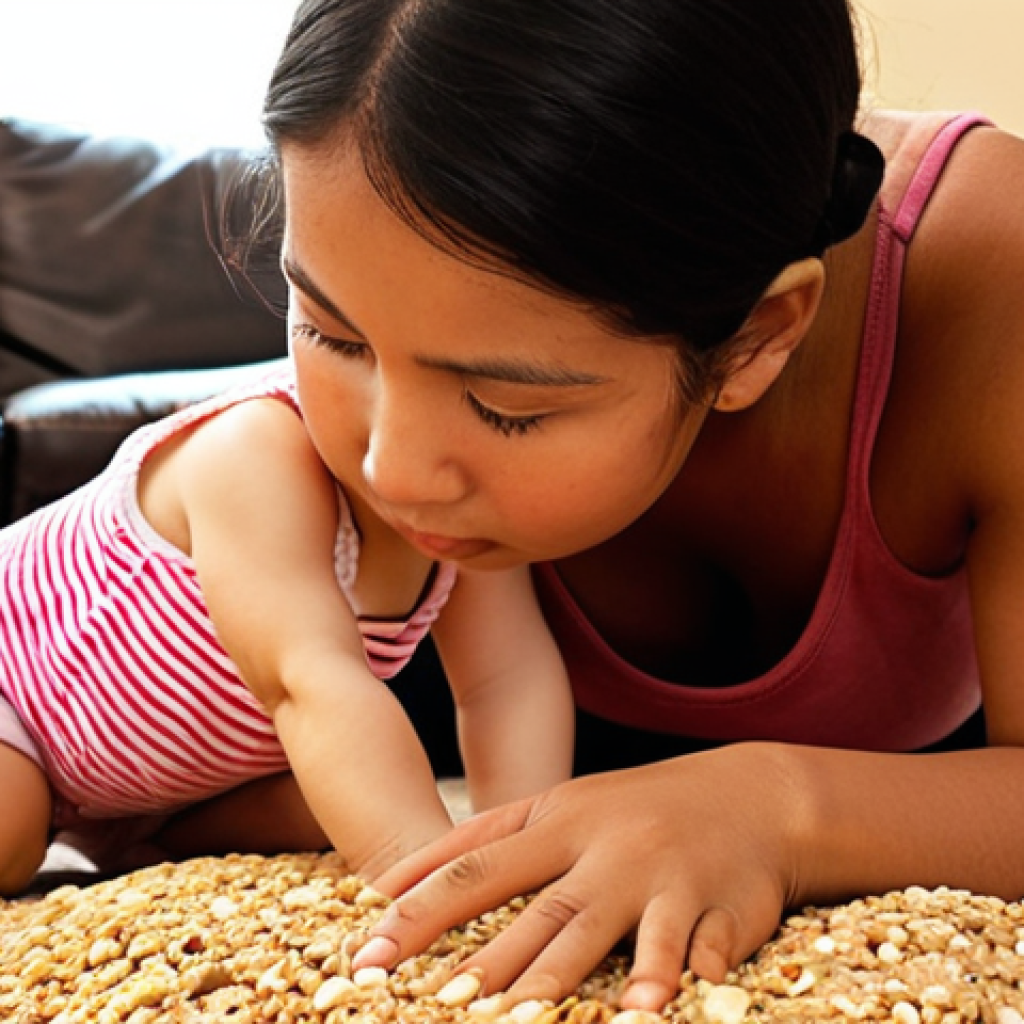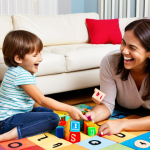I vividly remember sitting on the floor, absolutely bewildered, trying to figure out why my toddler just poured cereal all over the cat – and more importantly, how to respond effectively.
If you’re a parent, you know that gut-wrenching feeling when conventional discipline advice doesn’t seem to fit your child’s age or temperament. The truth is, effective discipline isn’t a one-size-fits-all formula; it evolves dramatically with every developmental stage, demanding an approach rooted in empathy and understanding.
We’re seeing a massive shift from traditional punitive methods towards strategies focused on emotional regulation and building genuine connection, reflecting cutting-edge research in child psychology.
This isn’t just about managing behavior; it’s about nurturing resilient, well-adjusted individuals in an ever-changing world. Let’s explore the details below.
I vividly remember sitting on the floor, absolutely bewildered, trying to figure out why my toddler just poured cereal all over the cat – and more importantly, how to respond effectively.
If you’re a parent, you know that gut-wrenching feeling when conventional discipline advice doesn’t seem to fit your child’s age or temperament. The truth is, effective discipline isn’t a one-size-fits-all formula; it evolves dramatically with every developmental stage, demanding an approach rooted in empathy and understanding.
We’re seeing a massive shift from traditional punitive methods towards strategies focused on emotional regulation and building genuine connection, reflecting cutting-edge research in child psychology.
This isn’t just about managing behavior; it’s about nurturing resilient, well-adjusted individuals in an ever-changing world. Let’s explore the details below.
Understanding the Developing Brain: More Than Just Milestones

When my first child was tiny, I genuinely believed that if I just said “no” enough times, they’d eventually get it. Oh, how naive I was! What I’ve learned, often through frustrating trial-and-error, is that a child’s capacity for self-regulation and understanding consequences is intrinsically linked to their brain development. You can’t expect a two-year-old to reason like a five-year-old, much less an adult. Their prefrontal cortex, the part responsible for planning, impulse control, and executive functions, is still very much under construction. This isn’t an excuse for misbehavior; it’s a foundational truth that shapes how we approach correction and teaching. I’ve personally found that once I shifted my perspective from “they’re being difficult” to “their brain is developing,” my patience grew, and my strategies became far more effective. It’s about meeting them where they are developmentally, not forcing them into an adult mold. This understanding fundamentally shifts discipline from punishment to teaching, recognizing that mistakes are opportunities for growth.
1. Decoding Early Childhood Behaviors
- The Sensory Seekers: Many young children are driven by sensory input. That cereal-pouring incident? My toddler was likely exploring texture and cause-and-effect. Instead of punishment, I realized redirection to a sensory bin or outdoor play could fulfill that need in a safer way.
- Language Limitations: Before they can articulate their feelings, children often express them through actions. Tantrums aren’t defiance; they’re often a cry for help when emotions overwhelm their limited vocabulary.
- Egocentric Worldview: Young children genuinely believe the world revolves around them. Sharing or understanding another’s perspective is a learned skill that takes years to master, not something they’re born with.
2. The Adolescent Brain: Navigating Identity and Independence
- Impulse Control: Even into the teenage years, the prefrontal cortex is still maturing. This explains some of the seemingly irrational decisions, from risky behaviors to emotional outbursts.
- Identity Formation: Adolescents are intensely focused on finding their place in the world. Discipline at this stage often involves giving space for exploration while maintaining clear, empathetic boundaries.
Beyond ‘No!’: Crafting Effective Boundaries with Empathy
I can still hear my own voice echoing through the house, a constant stream of “no, no, no!” It became so routine that I think my kids just tuned it out. It was exhausting for me and utterly ineffective for them. What I’ve come to understand is that effective boundaries aren’t about shutting down behavior; they’re about guiding it. It’s a dance between clear expectations and profound empathy. Instead of just stating what *not* to do, we need to articulate what *to do* and *why*. This means explaining consequences not as punishments, but as natural outcomes. For instance, instead of “No running inside!” try “We walk inside to keep our bodies safe and avoid breaking things.” The shift in language is subtle but profound in its impact on a child’s understanding and willingness to cooperate. It’s about teaching them self-control and respect for their environment, rather than just blind obedience.
1. The Power of “Yes, If” and Redirection
- “Yes, If”: Instead of an outright “no,” try “Yes, you can have a cookie, if you finish your vegetables first.” This teaches delayed gratification and reinforces positive habits.
- Strategic Redirection: For the cat-cereal incident, instead of punishment, I immediately redirected to a less messy, supervised sensory activity. This met the underlying need without creating a power struggle.
2. Involving Children in Setting Expectations
- Family Meetings: Even young children can participate in setting household rules. When they have a say, they’re far more likely to adhere to them. It creates a sense of ownership.
- Consequence Conversations: Discuss potential consequences beforehand. “If we leave our toys out, they might get stepped on and broken.” This helps them understand cause and effect.
Connecting Through Conflict: Building Emotional Intelligence
There have been countless times when a disagreement or a tantrum would send my stress levels soaring, and my immediate reaction was to just make it stop. But my children taught me, often through their sheer persistence, that true discipline isn’t about shutting down emotions; it’s about acknowledging them. I learned to lean in, to validate their feelings even if I didn’t agree with their actions. “I see you’re really angry right now because you wanted another cookie. It’s okay to feel angry.” This simple act of validation, followed by a clear boundary, created a breakthrough in our connection. It’s a core principle of emotional intelligence: understanding and managing one’s own emotions, and recognizing the emotions of others. When we connect through conflict, we teach our children that all feelings are acceptable, even if all behaviors aren’t. This approach builds a foundation of trust, making them more likely to come to us when they truly need help navigating tough emotions down the line. It’s messy, it’s not always quick, but it’s incredibly powerful.
1. Validating Feelings, Guiding Behavior
- Active Listening: Really listen to what they’re trying to communicate, even if it’s through tears or yelling. Repeat back what you hear (“You’re upset because…”).
- Name the Emotion: Help them put words to their feelings: “It looks like you’re feeling frustrated.” This builds their emotional vocabulary.
2. Repairing and Moving Forward
- Apology and Empathy: Teach them to apologize when they’ve hurt someone, and to truly understand the other person’s feelings. This isn’t just saying “sorry”; it’s about genuine remorse and connection.
- Problem-Solving Together: Once emotions have calmed, work together to find solutions. “What could we do differently next time?”
The Power of Positive Reinforcement: Beyond Gold Stars
I used to think positive reinforcement meant a sticker chart and a “good job!” whenever they did something right. And while those things have their place, I’ve realized that true positive reinforcement goes so much deeper. It’s about catching your child being good, noticing their effort, and genuinely appreciating who they are, not just what they do. I remember one afternoon my son, completely unprompted, put all his toys away. Instead of just a quick “thanks,” I knelt down and said, “Wow, you took the initiative to clean up all your toys by yourself! That shows such responsibility, and it makes our living room feel so much calmer.” The look on his face was pure pride. It wasn’t about a reward; it was about acknowledging his intrinsic motivation and building his sense of competence. This kind of affirmation fosters internal drive, encouraging children to repeat positive behaviors because they feel good about themselves, not just to earn something externally. It’s a subtle yet profound shift from external rewards to internal validation.
1. Specific Praise and Effort Recognition
- Be Specific: Instead of “Good job,” try “I love how carefully you stacked those blocks!” or “You worked so hard on that drawing!”
- Praise Effort, Not Just Outcome: Focus on the process: “I saw you didn’t give up even when it was tricky.” This builds resilience.
2. Creating a Positive Home Environment

- Family Values: Establish and regularly discuss core family values (e.g., kindness, honesty, perseverance) that guide behavior.
- Time and Attention: The greatest positive reinforcement is often simply your engaged, positive attention. Spend quality time, play together, and genuinely connect.
Navigating Tantrums and Meltdowns: A Parent’s Compass
Oh, the tantrums. My personal Everest. I’ve been there, pinned under the wailing, flailing body of a small human in the middle of a grocery store, feeling the judgment of every passerby. My initial instinct was always to either give in or yell back. Neither worked. What I eventually learned, through a lot of reading and even more deep breaths, is that tantrums and meltdowns are not the same, and they require different responses. A tantrum is often a child trying to get something or avoid something, a power play. A meltdown, however, is a complete loss of control, an emotional overload where the child genuinely can’t cope. Once I understood this distinction, my “compass” for navigating these storms became clearer. It’s about staying calm, recognizing the difference, and responding with either firm boundaries (for a tantrum) or calm co-regulation (for a meltdown). It’s incredibly challenging, but it’s an opportunity to teach emotional resilience.
1. Distinguishing Tantrums from Meltdowns
- Tantrum Characteristics: Often have a clear goal (e.g., wanting candy), might stop if they get what they want, often performative (looking to see if you’re watching).
- Meltdown Characteristics: Complete loss of control, no clear goal, child is genuinely overwhelmed and cannot calm themselves, often triggered by sensory overload or intense emotion.
2. Strategies for Each Scenario
Here’s a quick overview of how I differentiate my approach based on the situation:
| Scenario | Child’s State | Parental Response |
|---|---|---|
| Tantrum | Goal-oriented, seeking control/item. Can often be redirected. | Stay calm, set firm boundaries, avoid giving in, redirect to a safer alternative, ignore if safe. |
| Meltdown | Overwhelmed, losing control, unable to reason. | Stay calm, offer comfort (hugs, quiet space), reduce stimuli, validate feelings (“I see you’re so overwhelmed”), wait it out. |
For a tantrum, I might calmly state, “I understand you want that toy, but we’re not buying it today. We can play with toys when we get home.” Then, if they continue, I might simply turn away (if safe) or offer a different, acceptable option. For a meltdown, my approach is purely supportive. I might hold them close, whisper comforting words, and simply ride out the storm with them, offering my calm presence as an anchor until they regulate.
Parental Well-being: Disciplining Yourself First
This is the one that no one really talks about enough, but it’s arguably the most crucial. I used to feel immense guilt after a particularly challenging day, replaying my own frustrated outbursts, knowing I hadn’t handled things perfectly. It was only when I started prioritizing my own well-being that I truly became a more effective parent. You can’t pour from an empty cup, right? Trying to practice empathetic, consistent discipline when you’re exhausted, stressed, or emotionally drained is like trying to run a marathon on a broken leg. It’s simply not sustainable. I’ve realized that “disciplining myself” means recognizing my own triggers, taking breaks when I need them, and building a support system. It’s about filling my own emotional reserves so I have the patience and presence of mind to respond thoughtfully, rather than react impulsively. This isn’t selfish; it’s absolutely essential for creating a calm, stable environment for my children. When I’m regulated, they are more likely to be regulated too.
1. Managing Your Own Emotional Triggers
- Identify Triggers: What consistently pushes your buttons? Lack of sleep? Mess? Disrespectful tones? Knowing these helps you prepare.
- Proactive Strategies: If lack of sleep is a trigger, prioritize rest. If mess, set up a system to manage it. Small changes can make a big difference.
- Take a Pause: When you feel yourself about to snap, take a deep breath, step away for a moment if possible, or use a pre-determined phrase like “Mommy needs a moment.”
2. Building a Support System and Self-Care Routine
- Lean on Your Village: Whether it’s a partner, family, or friends, don’t be afraid to ask for help or just vent. Parenting is hard, and you don’t have to do it alone.
- Non-Negotiable Self-Care: Even 15-30 minutes a day of something you enjoy – reading, exercise, a quiet cup of coffee – can be transformative. It’s not a luxury; it’s a necessity.
Closing Thoughts
Navigating the complex world of child discipline is truly one of parenting’s greatest challenges, yet also its most rewarding. It’s a journey not of perfection, but of continuous learning, growth, and connection.
By embracing empathy, understanding your child’s developing brain, and prioritizing your own well-being, you’re not just managing behaviors; you’re cultivating a foundation of trust, resilience, and emotional intelligence that will serve your children long into adulthood.
Remember, every challenging moment is an opportunity to teach, to connect, and to build a stronger bond. You’ve got this.
Useful Resources and Next Steps
1. Explore Reputable Parenting Resources: Dive deeper into books like “The Whole-Brain Child” by Daniel J. Siegel and Tina Payne Bryson, or “Positive Discipline” by Jane Nelsen. They offer invaluable frameworks and practical strategies grounded in child psychology.
2. Connect with Your Community: Join local parenting groups, online forums, or even start a WhatsApp chat with fellow parents. Sharing experiences and advice can be incredibly validating and provide fresh perspectives.
3. Consider Professional Guidance: If you find yourself consistently struggling or feel overwhelmed, don’t hesitate to consult a child psychologist, family therapist, or parenting coach. A personalized approach can make all the difference.
4. Practice Mindful Parenting: Incorporate moments of mindfulness into your day. Taking a few deep breaths before responding to a challenging situation can dramatically improve your reaction and overall calm.
5. Prioritize Self-Compassion: Parenthood is messy. There will be days when you feel you’ve failed. Treat yourself with the same kindness and understanding you offer your children. Growth happens over time, not overnight.
Key Takeaways
Effective discipline evolves with a child’s developmental stage, moving beyond punitive methods to focus on understanding their brain and emotions. Empathy, clear boundaries, positive reinforcement, and consistent parental self-care are fundamental. Every challenging moment offers a chance to connect, teach emotional intelligence, and build a resilient, trusting relationship with your child.
Frequently Asked Questions (FAQ) 📖
Q: Why is it so difficult to apply “one-size-fits-all” discipline, and what’s the real problem with traditional, punitive methods, especially for younger kids?
A: Oh, believe me, I’ve been there, banging my head against the wall trying to make a perfectly sensible ‘time-out’ work for a screaming two-year-old who just wanted to throw their toy train at the TV.
The truth is, kids aren’t miniature adults; their brains are still building the superhighways for impulse control and logical reasoning. So, when you try a blanket discipline approach, it often feels like you’re speaking a language they simply don’t comprehend.
Traditional punitive methods, like harsh punishments or shame, might stop the behavior in the short term, but from what I’ve observed firsthand, they often just teach kids to fear consequences or hide their actions, rather than truly understanding why something was wrong.
It’s like trying to patch a leaky boat with duct tape – it might hold for a bit, but it doesn’t fix the underlying structural issue. They don’t learn how to manage big emotions or solve problems; they just learn how to avoid getting caught.
Q: What does this “approach rooted in empathy and understanding” actually look like when my child is throwing a major tantrum in public or doing something genuinely frustrating?
A: That’s the million-dollar question, isn’t it? It’s not about being a pushover or letting them get away with anything. From my own journey, embracing empathy means first acknowledging their huge, messy feelings.
Think of it like this: your child isn’t giving you a hard time; they’re having a hard time. So, when my kid melted down over a broken cookie, instead of immediately saying “That’s silly!” (which was my initial, unhelpful impulse), I learned to say, “Wow, you’re really sad and mad about that cookie, aren’t you?
That’s so frustrating when something breaks.” Once those big emotions are named and validated – it often disarms the situation – then you can gently guide them towards a solution or set a boundary.
It’s about connecting before correcting. It shifts the dynamic from a power struggle to a teaching moment, building trust rather than resentment. Honestly, it felt totally counterintuitive at first, like I was doing it “wrong,” but the long-term payoff in connection and cooperation has been nothing short of transformative.
Q: How can a parent, who might be used to more traditional methods, start shifting towards these new, research-backed strategies focused on emotional regulation and connection? It feels like a massive overhaul!
A: I hear you, it absolutely feels daunting, like you need to completely rewire your parenting brain. When I first started diving into this, I felt overwhelmed, wondering where to even begin.
My advice? Don’t try to overhaul everything overnight; that’s a recipe for burnout. Start small, with one specific area.
Maybe it’s focusing on genuinely listening when your child is upset, even if you don’t agree with their reasoning. Or perhaps, before reacting to a misbehavior, take a breath and try to understand why they might be acting that way – are they tired, hungry, overwhelmed, seeking attention?
A fantastic first step is simply observing your child’s behavior as communication, not just defiance. Another practical tip I swear by is proactive connection.
Spend 10-15 minutes of uninterrupted, silly, focused playtime with your child daily. Fill their “attention cup” when things are calm, and you’ll find they have less need to act out to get that attention.
It’s a marathon, not a sprint, and there will be messy days. But even tiny shifts toward empathy and understanding can make a profound difference in the whole family’s emotional landscape.
You’re building a stronger, more resilient foundation, one small, intentional step at a time.
📚 References
Wikipedia Encyclopedia
구글 검색 결과
구글 검색 결과
구글 검색 결과
구글 검색 결과
구글 검색 결과


